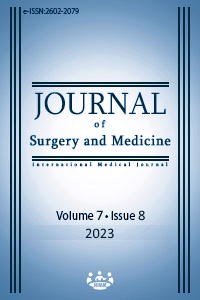Removal of foreign objects seen in the upper gastrointestinal tract with the help of endoscopy: A retrospective cohort study
Removal of foreign objects with endoscopy
Keywords:
gastrointestinal tract, endoscopy, foreign body, minimally invasive approachAbstract
Background/Aim: Delay in diagnosing and treating gastrointestinal (GI) tract foreign bodies may lead to serious complications. In this study, we aimed to retrospectively evaluate the patients who underwent emergency upper GI endoscopy for foreign body ingestion in our clinic.
Methods: Between 2015 and 2022, we evaluated 68 patients who underwent emergency upper GI endoscopy with a prediagnosis of foreign body ingestion. The evaluation included factors such as age, gender, presenting complaints, foreign body type, localization, and treatment parameters.
Results: Out of the 68 patients included in the study, 21 (30.89%) were female, and the mean age was 54.00 years. Among them, 43 (63.23%) presented with no active complaints, 23 (33.82%) with dysphagia and odynophagia, and two (2.94%) with vomiting. The swallowed objects were classified as follows: coin (n=2), pin (n=5), battery (n=11), drug plaque (n=6), esophageal foreign body (n=7), piece of meat (n=5), chicken bone (n=4), fish bone (n=5), razor (n=7), lighter (n=3), and toothpick (n=1). The foreign bodies were located in the esophagus in 23 cases (33.82%), in the stomach in 32 cases (47.05%), and in the duodenum in one case (1.47%). For 12 patients (17.64%), the foreign body could not be detected endoscopically but was detected using radiologic methods. Among the foreign bodies, 54 (79.41%) were successfully removed. In one patient (1.47%) who could not be removed endoscopically and another patient (1.47%) who developed gastrointestinal perforation due to a foreign body (toothpick), a surgical procedure was performed.
Conclusion: Early diagnosis and treatment of foreign body ingestion are crucial in preventing serious complications. Endoscopy, a minimally invasive procedure, can be a safe alternative to surgical procedures, which may carry higher morbidity and mortality risks.
Downloads
References
Eisen GM, Baron TH, Dominitz JA, Faigel DO, Goldstein JL, Johanson JF, et al. Complications of upper GI endoscopy. Gastrointest Endosc. 2002;55(7):784-93. PMID: 12024128 doi: 10.1016/s0016-5107(02)70404-5. DOI: https://doi.org/10.1016/S0016-5107(02)70404-5
Coşkun S. Endoscopic removal of multiple esophagogastric foreign bodies without complication. J Contemp Med 2022;12(2):377-383. doi:10.16899/jcm.985835. DOI: https://doi.org/10.16899/jcm.985835
Obinwa O, Cooper D, O’Riordan JM, Neary P. Gastrointestinal Foreign Bodies. Actual Problems of Emergency Abdominal Surgery. 2016;75-94. doi: 10.5772/63464. DOI: https://doi.org/10.5772/63464
Diaconescu S, Gimiga N, Sarbu I, Stefanescu G, Olaru C, Ioniuc I, et al. Foreign Bodies Ingestion in Children: Experience of 61 Cases in a Pediatric Gastroenterology Unit from Romania. Gastroenterol Res Pract. 2016;2016:1982567. PMID: 26949384 doi: 10.1155/2016/1982567. DOI: https://doi.org/10.1155/2016/1982567
Kafadar S, Kafadar H. Gastrointestinal Yabancı Cisim Olgularının incelenmesi. ADYÜ Sağlık Bilimleri Derg. 2019;5(2):1620-7. doi: 10.30569/adiyamansaglik.593467. DOI: https://doi.org/10.30569/adiyamansaglik.593467
Hong KH, Kim YJ, Kim JH, Chun SW, Kim HM, Cho JH. Risk factors for complications associated with upper gastrointestinal foreign bodies. World J Gastroenterol 2015;21:8125-31. doi: 10.3748/wjg.v21.i26.8125. DOI: https://doi.org/10.3748/wjg.v21.i26.8125
Smith MT, Wong RK. Esophageal foreign bodies: types and techniques for removal. CurrTreat Options Gastroenterol. 2006;9(1):75-84. PMID: 16423316 doi: 10.1007/s11938-006-0026-3. DOI: https://doi.org/10.1007/s11938-006-0026-3
Weiland ST, Schurr MJ. Conservative management of ingested foreign bodies. J GastrointestSurg. 2002;6(3):496-500. PMID: 12023005 doi: 10.1016/s1091-255x(01)00027-0. DOI: https://doi.org/10.1016/S1091-255X(01)00027-0
Webb WA. Management of foreign bodies of the upper gastrointestinal tract: update. Gastrointest Endosc. 1995;41(1):39-51. PMID: 7698623 doi: 10.1016/s0016-5107(95)70274-1. DOI: https://doi.org/10.1016/S0016-5107(95)70274-1
Litovitz T, Schmitz BF. Ingestion of cylindrical and button batteries: an analysis of 2382 cases. Pediatrics.1992;89:747-57. PMID: 1557273. DOI: https://doi.org/10.1542/peds.89.4.747
Guelfguat M, Kaplinskiy V, Reddy SH, DiPoce J. Clinical guidelines for imaging and reporting ingested foreign bodies. Am J Roentgenol. 2014;203(3):694. PMID: 24951194 doi: 10.2214/AJR.13.12185. DOI: https://doi.org/10.2214/AJR.13.12185
Litovitz T, Whitaker N, Clark L, White NC, Marsolek M. Emerging battery-ingestion hazard: clinical implications. Pediatrics. 2010;125(6):1168-77. PMID: 20498173 doi: 10.1542/peds.2009-3037. DOI: https://doi.org/10.1542/peds.2009-3037
Wang X, Zhao J, Jiao Y, Wang X, Jiang D. Upper gastrointestinal foreign bodies in adults: A systematic review. Am J EmergMed. 2021;50:136-41. PMID: 34365062 doi: 10.1016/j.ajem.2021.07.048. DOI: https://doi.org/10.1016/j.ajem.2021.07.048
Velitchkov NG, Grigorov GI, Losanoff JE, Kjossev KT. Ingested foreign bodies of the gastrointestinal tract: retrospective analysis of 542 cases. World journal of surgery, 1996;20(8):1001–5. PMID: 8798356 doi: 10.1007/s002689900152. DOI: https://doi.org/10.1007/s002689900152
Misdrahi D, Llorca PM, Lancon C, Bayle FJ. Compliance in schizophrenia: predictive factors, therapeutical considerations and research implications. Encephale, 2002;28(3):266-72. PMID: 12091789.
Bayındır S, Koçyiğit F, Kahraman M. Interesting Suicidal Attempt of Schizophrenia Patient: Nine Cylindrical Batteries in Abdomen. J ClinPsy. 2016;19(1):52-5. doi: 10.5505/kpd.2016.43531. DOI: https://doi.org/10.5505/kpd.2016.43531
Hammami MB, Alkaade S, Piraka C, Taylor JR. Endoscopic Retrieval vs Observation in Cylindrical Battery Ingestion. Ochsner J. 2019;19(2):157-65. PMID: 31258428 doi: 10.31486/toj.18.0020. DOI: https://doi.org/10.31486/toj.18.0020
Anderson KL, Dean AJ. Foreign bodies in the gastrointestinal tract and anorectal emergencies. EmergMedClin North Am. 2011;29(2):369-ix. PMID: 21515184 doi: 10.1016/j.emc.2011.01.009. DOI: https://doi.org/10.1016/j.emc.2011.01.009
Akay T. Should we remove the alkaline batteries, which are got caught in upper gastrointestinal segment, immediately? Clinical and Experimental Health Sciences. 2020;10(3):275-8. doi: 10.33808/clinexphealthsci.687517.
O’Sullivan ST, Reardon CM, McGreal GT, Hehir DJ, Kirwan WO, Brady MP. Deliberate ingestion of foreign bodies by institutionalised psychiatric hospital patients and prison in mates. Irishjournal of medicalscience, 1996;165(4):294–6. PMID: 8990660 doi: 10.1007/BF02943095. DOI: https://doi.org/10.1007/BF02943095
Downloads
- 728 1504
Published
Issue
Section
How to Cite
License
Copyright (c) 2023 Alpaslan Fedayi Çalta
This work is licensed under a Creative Commons Attribution-NonCommercial-NoDerivatives 4.0 International License.
















